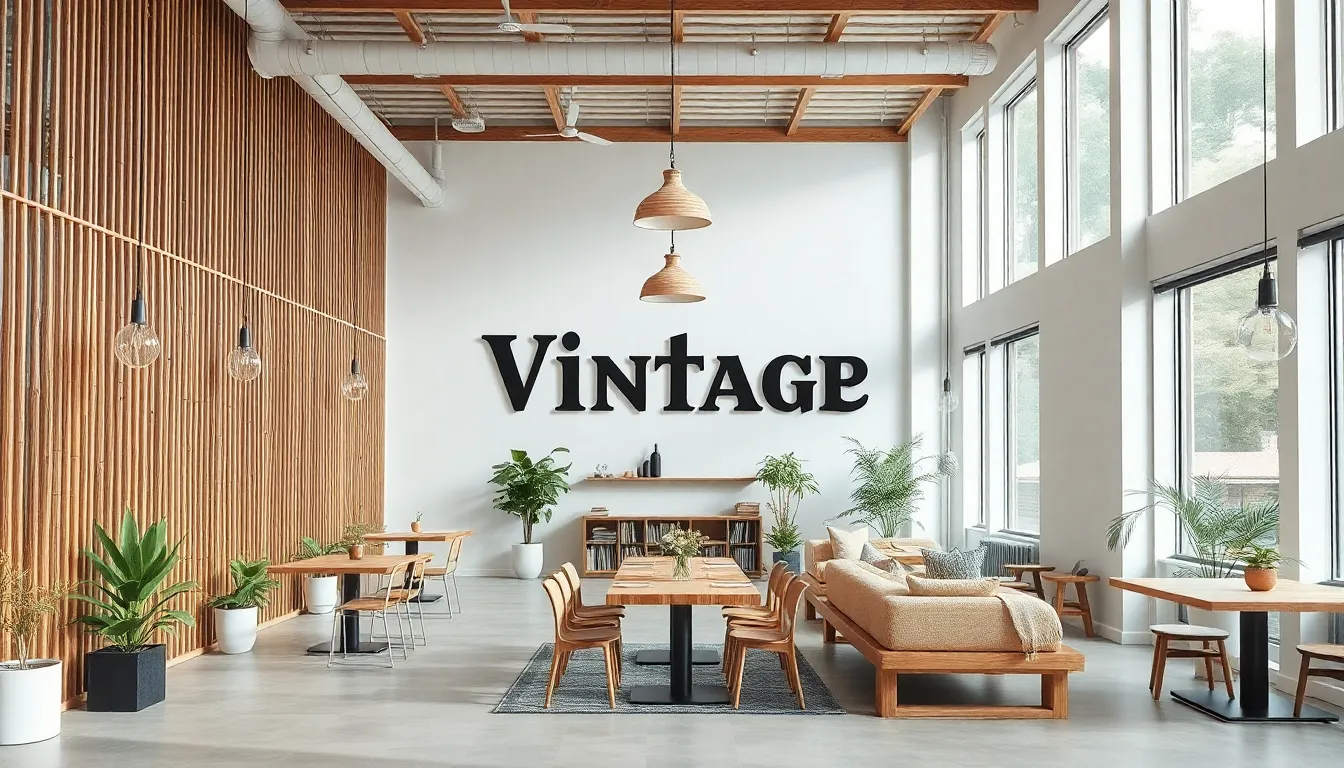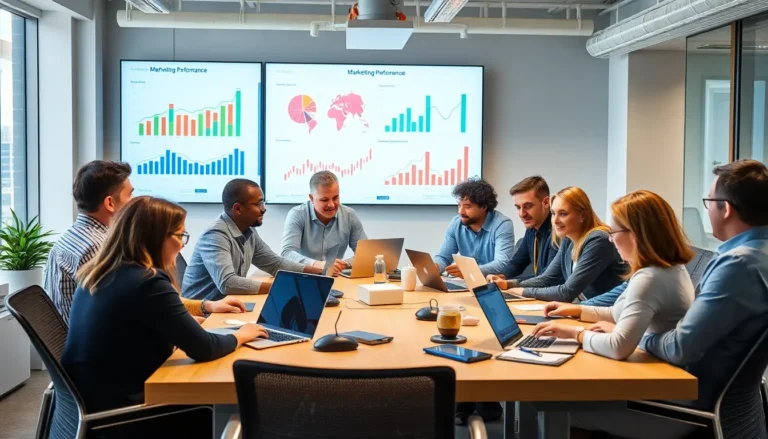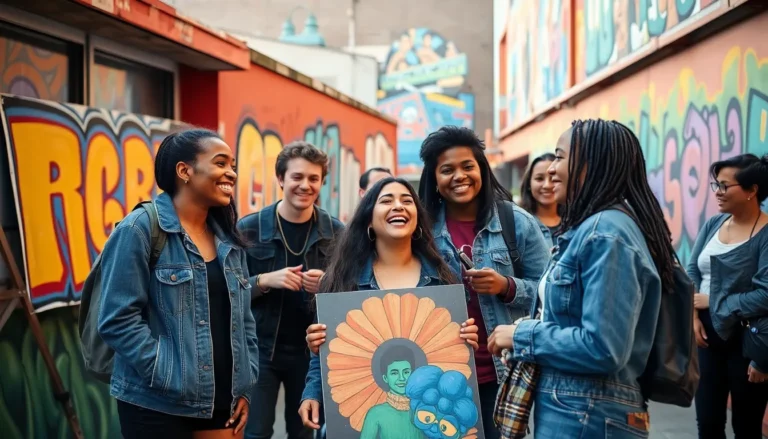In a world where first impressions matter more than ever, design trends are the secret sauce that can turn the ordinary into the extraordinary. Whether it’s a sleek website or a cozy coffee shop, the right design can make hearts race and wallets open. But hold onto your sketch pads—trends change faster than a cat video goes viral!
Table of Contents
ToggleOverview of Design Trends
Design trends shape creativity and functionality in various fields, including architecture, graphic design, and web development. Minimalism continues to dominate, focusing on simplicity and the effective use of space. Color palettes lean towards earthy tones, promoting a sense of calm and connection to nature. Typography experiments with bold fonts, enhancing visual hierarchy and user engagement.
Sustainable design practices gain traction, as consumers increasingly prioritize eco-friendly materials and processes. Smart technology integration rises, offering seamless interactions in everyday designs. Virtual and augmented reality experiences enhance product visualization, attracting users in innovative ways.
User-centered design principles emphasize understanding target audiences. Emotional engagement in product design fosters loyalty, making designs more relatable. Interactive elements in websites and apps enhance user experience, encouraging exploration and retention.
Diversity in representation becomes vital, reflecting varied demographics in visual content. Adaptive design ensures accessibility, catering to users with different abilities and preferences. The balance between aesthetics and function becomes central in cutting-edge design approaches, guiding decisions toward practical yet appealing solutions.
Each trend contributes to an evolving landscape, fostering innovative solutions in an increasingly competitive market. Designers must stay informed and embrace emerging trends to create lasting impressions and exceptional experiences.
Current Design Trends

Design trends continuously evolve, shaping creativity and functionality in various fields. Staying updated on these trends remains essential for success.
Minimalism in Design
Minimalism emphasizes simplicity, minimal clutter, and effective use of space. Designers prioritize clean lines and open layouts, creating an uncluttered aesthetic that enhances focus. Functionality drives this trend; each element serves a purpose. In addition, minimalism cultivates a calming atmosphere, making it ideal for both interior and graphic design. Attention shifts to strategic placement of essential elements. This approach resonates with users, allowing them to engage more deeply with the content or environment.
Sustainability in Design
Sustainable design practices prioritize eco-friendly materials and processes. Designers increasingly incorporate recycled resources, reducing waste and energy consumption. Consumers demand greener options, pushing brands to innovate in sustainable product development. This trend involves utilizing natural materials such as bamboo and reclaimed wood, emphasizing both aesthetics and ecological impact. Interconnectedness with nature influences design choices, fostering emotional connections with users. By integrating sustainability, designers enhance brand loyalty, showcasing a commitment to environmental stewardship.
Bold Typography Choices
Bold typography captures attention and enhances communication effectiveness. Designers explore varied font styles, experimenting with weight and size to create visual hierarchy. Unique typographic choices engage users, contributing to a memorable brand identity. Clear, readable text plays a critical role in reducing cognitive load while providing impactful messaging. Mixing fonts thoughtfully allows for creative expression and differentiation among brands or projects. Overall, these bold typography choices enable deeper emotional engagement, making them essential for modern design approaches.
Emerging Design Trends
Emerging design trends highlight new directions that shape creative expression and user experiences. Designers continually adapt to these shifts, fostering innovation.
Mixed Media and Textures
Mixed media combines various materials and textures to create visually striking designs. This trend embraces contrasting elements, enhancing depth and engagement. Designers use materials like wood, metal, and fabric, resulting in unique combinations that resonate emotionally. Textures add dimension to spaces and graphics, allowing users to interact with environments or websites in remarkable ways. By incorporating tactile elements, designers create memorable experiences that cater to diverse preferences.
Virtual and Augmented Reality
Virtual and augmented reality technologies transform how users engage with design. These tools enable immersive experiences, allowing users to visualize products in real-time. Designers leverage VR and AR to create simulations that enhance understanding and emotional connection. Interactive features showcase products effectively, prompting users to explore features and benefits. As accessibility improves, many industries adopt these technologies, enriching user experiences and driving greater interaction through innovative design solutions.
Impact of Technology on Design Trends
Technology profoundly influences design trends across various sectors. Innovations in software and hardware introduce new tools that streamline the creative process, enhancing the efficiency of designers. Examples include advanced graphic design software and 3D modeling programs that allow for greater precision and creativity.
Smart technology reshapes interactive design by enabling seamless user experiences. Products equipped with IoT capabilities foster real-time interaction and personalization, creating deeper connections between the user and the design. Virtual and augmented reality tools amplify this effect by providing immersive environments that encourage exploration and interaction.
Machine learning algorithms analyze user behavior, guiding designers in creating tailored solutions that meet specific needs. Utilizing this data, designers can refine their approaches, ensuring that each element serves a purpose while enhancing the overall experience.
Sustainable design gains traction through technological innovations that facilitate eco-friendly practices. Technologies for sourcing renewable materials and reducing waste foster greater awareness among designers and consumers alike. This shift emphasizes the importance of sustainable choices within the design process, aligning with consumer values and expectations.
Diversity in design also sees a boost from technology. Augmented reality apps permit users to visualize products in various contexts, appealing to a broader audience. By embracing inclusivity, designers can cultivate a sense of belonging and connection with diverse user bases.
Typography evolves in response to technological advancements. Dynamic fonts that adapt to various screens improve readability and engagement. The creative exploration of font combinations allows brands to express unique identities while communicating effectively.
Overall, technology drives creativity and innovation in design. Designers must embrace these advancements, ensuring their work remains relevant and impactful in an ever-changing landscape. Staying updated with these trends leads to exceptional experiences that resonate with users.
Design trends play a crucial role in shaping user experiences and enhancing brand identities. As these trends continue to evolve rapidly staying informed is essential for designers aiming to make a lasting impact. Embracing minimalism sustainability and innovative technologies allows designers to create spaces and products that resonate deeply with users.
The emphasis on user-centered design and diversity ensures that every individual feels represented and engaged. By integrating bold typography and mixed media designers can push creative boundaries while maintaining functionality. As the design landscape shifts it’s vital for professionals to adapt and innovate continually, fostering exceptional experiences that stand out in a competitive market.


